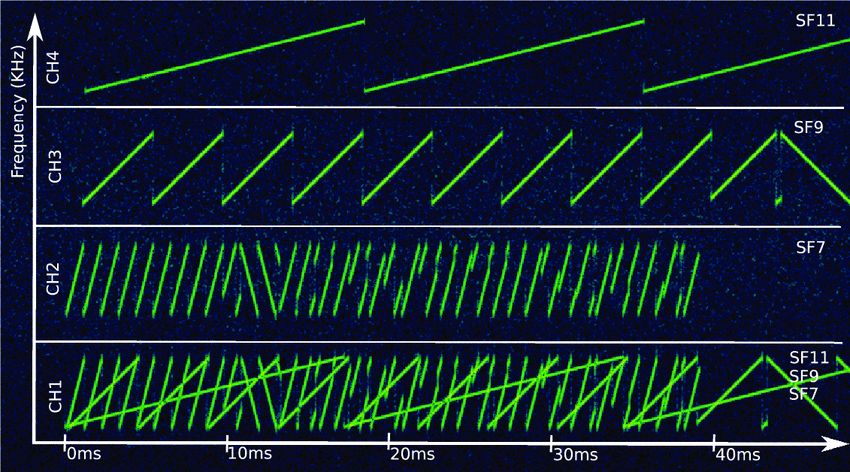Hello together,
I try to understand the orthogonality of the SF. A multi channel Gateway receives 2 Messages at the same frequency (same Chanel) and at the same time with different SF. The Message interfere, but because of the different SF both Message are demodulated correctly, if the SNR is high enough ? Is this right ?
Thanks for your Help !
That’s about right, though “interfere” may not be the right word.
It might be helpful if you could find spectral waterfall displays of messages at different SF’s.
One way to think about it is in that a classic narrowband system, frequency is what keeps the energy of different systems able to be distinguished even though various combined waves add to a higher or lower total at any instant in time.
In LoRa you can extend the role that frequency played in narrowband, to include particular aspects of how the frequency changes - two trends might cross paths, but they remain distinct and recognizable by something designed to track one of those trends through the limited set of ways it can change under the modulation scheme.
Yes, That’s right. I understand what you say. But my problem is more like, what means the orthogonality for the Transimission of a Uplink of two different End Devices on the same Channel on the same time…Maybe this describes my problem a little bit better
As I said before, it means they “look different” as trends of frequency; they might cross paths but remain distinctly identifiable, both visually and to a demodulator which is only trying to distinguish between the changes that the modulation can actually do.
It would be as if you were looking at a street a long way away and saw a person running pass someone identically dressed who was walking - even though there’d be an instant when they were at the same azimuth, you’d not have any trouble knowing which was which as they separated again.
If you want to make it a little more LoRa like, say they are both moving back and forth, and what you want to see is when they change direction to go the other way; you can still tell the pattern of the runner from the walker by their movement into and out of the change.
As before, finding some waterfall plots would be illustrative.
Looking at the waterfall you will see that each SF has a different pitch on a time over frequency graph.
Shown in the picture below is a single scan for each spreading factor. A full packet would consist of several sequential transmissions of lines moving left to right and random chirps on the lines following the preamble.

Waterfall graphs can be seen in this article.
https://www.digikey.com/en/articles/lorawan-part-1-15-km-wireless-10-year-battery-life-iot
When I saw it, It was clear to me. It’s very easy to distinguish fast and slow glissandi ![]()

I can’t find the post, but the problem is that concentrators don’t have 56 decoders (7SF * 8Channels)
So from sx1308 datasheet:
The SX1308 digital baseband chip scans the 8 channels (IF0 to IF7) for preambles of all data rates at all times. The chip is able to demodulate simultaneously up to 8 packets. Any combination of up to 8 packets is possible (e.g. one SF7 packet on IF0, one SF12 packet on IF7 and one SF9 packet on IF1 simultaneously).
The SX1308 can detect simultaneously preambles corresponding to all data rates on all IF0 to IF7 channels. However it cannot demodulate more than 8 packets simultaneously. This is because the SX1308 architecture separates the preamble detection and acquisition task from the demodulation process. The number of simultaneous demodulation (in this case 8) is an arbitrary system parameter and may be set to any value for a customer specific circuit.
SX1302 has more
- 8 x SF5-SF12 LoRa® demodulators
- 8 x SF5-SF10 LoRa® demodulators
Thank you all,
So the Receiver Chip can seperate them, but there ist capacity problem of the demodulation paths ? And so if there is a parallel 8 Path Demodulator, you can only demodulate 8 messages, independently of the SF ?
Hi, I think the question you are asking is “what makes the two uplink transmissions on the same channel (frequency) have different Spreading Factors.”
The answers is nothing. The network does not direct the two nodes to have different SF so they could have the same SF or they could be different.
The SF is either fixed or is negotiated by ADR and this is the result of path loss, proximity to the gateway and so on.
As a result a number of nodes could have the same SF or they could be different and if they are different and on the same channel they may be decoded. Therefore it looks somewhat random, nodes transmit at random times, on one of 8 random channels and sometimes on different SF. Therefore not all transmissions are decoded but there is a percentage that are.
So the way to think of this, there is a probability that two simultaneous transmissions are received and successfully decoded.
There are 8 demodulators which are dynamically assigned when the pre-amble detectors see signal possibilities - eg, “demodulator #3: go try to make sense of what’s coming in on channel 5 at SF9”
Yes, since there are 8 a gateway could run out; not clear that happens very often since nodes are fairly likely to transmit on interefering channel/SF combos as luck out in avoiding each other. I have seen two quite in range gateways collect slightly different sets of signals, but I don’t recall the volume of signal reports making it seem like the chip was saturated.
The SX1302 chip adds more demodulator paths so that’s an option if you are particularly concerned; of more general interest is that it also consumes much less power and so runs cooler (it also adds some other things like modes useful for space work, though that likely has practical meaning for few)
Almost. One more problem is that if one signal is louder (7-12dB relative to SF*) it masks the other.
To my understanding, that’s the reason that you need ADR enabled devices. You maximize the capacity of the gateway if the signals have around the same dB.
- search the forum for this info.